Science
Staring Hitchhikers
Will hitchhikers get more rides if they stare at oncoming drivers or if they look away? A 1974 study published in the Journal of Applied Social Psychology attempted to answer this question:In the stare conditions, E stared at the driver of the target vehicle and attempted to fixate on the driver's gaze and maintain this gaze as long as possible until the driver either stopped his vehicle or drove on. In the comparison conditions, E looked anywhere else but at the driver. Thus, on some trials E looked in the general direction of the car; on other trials E looked at his feet, the road, the sky, etc. Es were specifically instructed to neither smile nor frown, and to maintain a casual (neither rigid nor slouching) body postural orientation while soliciting rides.
The two hitchhikers were described as, "both 20 years of age and both dressed in bluejeans and dark coats. The male had short, curly blond hair, and the female, straight, shoulder length blond hair. Both could be described as neat, collegiate, attractive in physical appearance, and of an appropriate age to be hitchhiking."
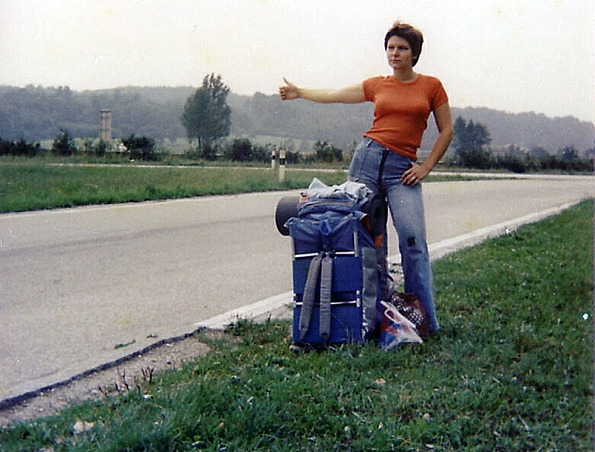
A hitchhiker in Luxembourg - Aug 1977 (source: wiktionary.org)
(not one of the hitchhikers in the study)
Staring is often interpreted as a threat. So the researchers anticipated that staring at oncoming drivers might result in fewer rides. But the opposite turned out to be true. Which is a useful tip to know if you ever need to hitchhike. But what really helped get a lot of rides was being a single female. From the study:
Contrary to popular belief and hitchhiking folklore , it was no easier for a male-female couple to hitch a ride than a single male, and a mixed sex couple was less successful at soliciting rides than a single female hitchhiker. Although the generality of this conclusion is limited by the fact that it is based upon results obtained by one male and one female E, it is probably the case that couples are less successful hitching rides because of space limitations in the cars they approach. That is, it is more likely that the driver will have room for one additional passenger than that he will have room for two or more additional passengers in his car.
Incidentally, the experimenters never actually ever got in a car with anyone: "After a motorist stopped to pick up one of the hitchhikers, he was politely thanked and given a printed description of the nature of the experiment. No driver expressed any discomfort when he learned that the hitchhiker did not actually want a ride."
Posted By: Alex - Mon May 04, 2020 -
Comments (5)
Category: Science, Experiments, Psychology, 1970s, Cars
Do Beavers Rule on Mars?
In the May 1930 issue of Popular Science magazine, Thomas Elway advanced the unusual hypothesis that Mars was inhabited by a race of beavers. His idea was subsequently reported in many newspapers.As far as I can tell, Elway wasn't actually a scientist. He was a journalist. So perhaps one shouldn't attach too much weight to his opinion. Still, he gets points for creativity.

Semi-Weekly Spokesman Review - Oct 12, 1930
Elway's argument was based on the assumption (widespread at the time) that there was plant life on Mars. Therefore, animal life was also considered possible. His reasoning then proceeded as follows:
This lack of manlike life is precisely what a biologist would expect. Man and man's active mind are believed to be products of the Great Ice Age, for that time of stress and competition on earth is what is supposed to have turned mankind's anthropoid ancestors into men. The period of ice and cold over wide areas of the earth was caused, at least in part, by the elevation of continents and mountain ranges. On Mars, no mountain ranges exist, and it probably never had an Ice Age.
It is on these hypotheses that science bases its assumption that there is no human intelligence on Mars, and that animal life on the planet is still in the age of instinct. The thing to expect on Mars, then, is a fish life much like that on earth, the emergence of this fish life onto the land, and the evolution of these Martian land-fishes into retilelike creatures. Finally, animals resembling the earth's present rodents like rats, squirrels, and beavers would make their appearance.
The chief reason to expect this final change of Martian retiles into primitive mammals lies in the fact that on earth this evolution seems to have been forced by changeable weather. And Mars now possesses seasonal changes like those on earth.
Pure biological reasoning makes it probable, therefore, that the evolution of warm-blooded animals may have occurred on Mars much as it did here. There seems no reason to believe that Martian life has gone farther than that. Mars is a relatively changeless planet. Biologists suppose that the rise and fall of mountains, the increase and decrease in volcanic activity, and the ebb and flow of climate forced life on earth along its upward path. Martian life of recent ages seems to have lacked these natural incentives to better things.
Now, there is one creature on earth for the development of whose counterpart the supposed Martian conditions would be ideal. That animal is the beaver. It is either land-living or water-living. It has a fur coat to protect it from the 100 degrees below zero of the Martian night.
The Martian beavers, of course, would not be exactly like those on earth. That they would be furred and water-loving is probable. Their eyes might be larger than those of the earthly beaver because the sunlight is not so strong, and their bodies might be larger because of lesser Martian gravity. Competent digging tools certainly would be provided on their claws. The chests of these Martian beavers would be larger and their breathing far more active, as there is less oxygen in the air on Mars.
Such beaver-Martians are nothing more than pure speculation, but the idea is based upon the known facts that there is plenty of water on Mars; that vegetation almost certainly exists there; that Mars has no mountains and could scarcely have had an Ice Age; and that evidences of Martian life are not accompanied by signs of intelligence.
Herds of beaver-creatures are at least a more reasonable idea than the familiar fictional one of manlike Martians digging artificial water channels with vast machines or the still more fantastic notion of octopuslike Martians sufficiently intelligent to plan the conquest of the earth.
Posted By: Alex - Thu Apr 02, 2020 -
Comments (5)
Category: Aliens, Animals, Science, 1930s
Can fear cure cancer?
In 1962, East German researchers conducted a bizarre medical experiment in an attempt to find out if fear could cure cancer. They inoculated some "mice, rabbits, rats, and cocks" with cancer cells. Then they put these animals into a cage which they lowered "into a zoo-like enclosure where 30 ravenous African polecats paced for food. The polecats would leap upon the little cage, shrieking and clawing at their hoped-for prey." This terror experience was repeated every two hours for several days.The result: the cancer cells grew more slowly in the terrorized animals.
Of course, this begs the question, what it is about fear that would fight cancer? Was it the elevated adrenalin levels? Or was there some other biochemical change that caused the effect?
Unfortunately, I can’t find any other details about this unusual experiment except for the brief news report below. I'm assuming there was never a human version of the experiment. Though one never knows, given some of the other stuff that researchers got up to behind the Iron Curtain.

The Paterson News - Nov 7, 1962
Posted By: Alex - Fri Mar 27, 2020 -
Comments (0)
Category: Medicine, Science, Experiments, 1960s
Relationship of noise tolerance to martini consumption
Back in the sixties, researchers weren't afraid to tackle the really important questions...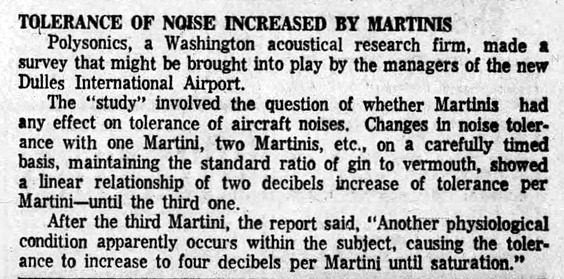
Knoxville News Sentinel - Dec 2, 1962
Posted By: Alex - Mon Feb 17, 2020 -
Comments (6)
Category: Science, 1960s, Alcohol, Cacophony, Dissonance, White Noise and Other Sonic Assaults
Does holy water help radishes grow better?
In 1979, researcher Sandra Lenington of the University of Santa Clara set out to answer this question. Her curiosity had been sparked by learning that Canon William V. Rauscher had reported that “canna plants given holy water left over from use in religious services grew more than three times higher than canna plants which were not given holy water.” She decided to try to duplicate his observations under more rigorous conditions.
She watered one group of radishes with regular water, and a second group with holy water. After three weeks, she concluded that there was “no significant difference in the growth rates of these radish plants given holy water versus radish plants given tap water.” She published her results in the journal Psychological Reports (1979, 45, 381-382).
However, she noted that Canon Rauscher believed in the power of holy water, whereas she didn’t, and this may have affected the outcome of her study: “There are numerous documented studies showing that positive or negative belief will either benefit or adversely affect plant growth.” She suggested that future studies might try to better control for this variable.
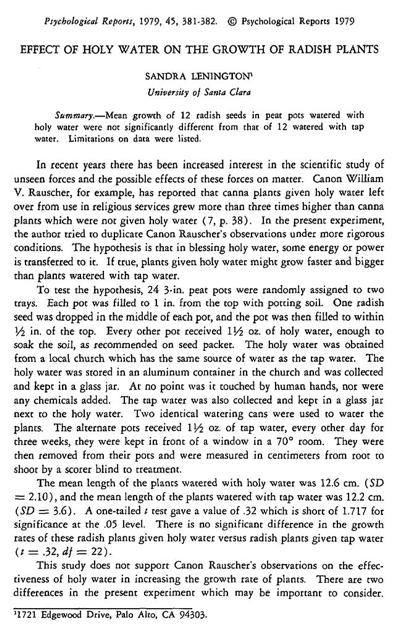
click to enlarge
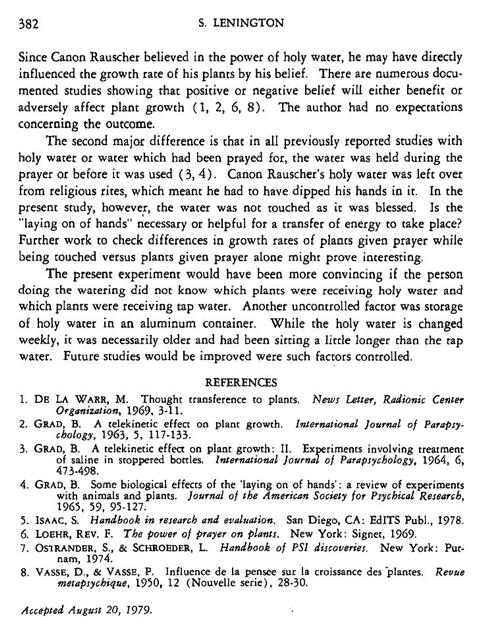
click to enlarge
Posted By: Alex - Sat Feb 01, 2020 -
Comments (3)
Category: Religion, Science, Vegetables, 1970s
Albert Clark Reed, Disappearing Rocket Scientist
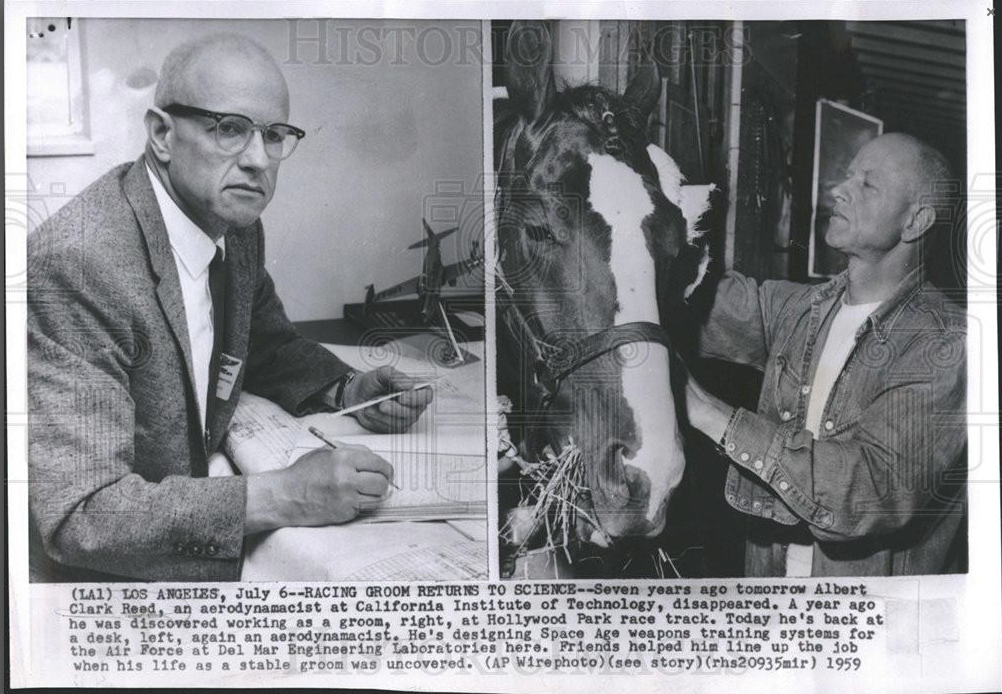
Foto source.
Read the full story here.
Posted By: Paul - Wed Nov 13, 2019 -
Comments (1)
Category: Ambiguity, Uncertainty and Deliberate Obscurity, Bad Habits, Neuroses and Psychoses, Eccentrics, Science, 1950s, Sadness
Tijuana Cows?
There's a tradition in Tijuana of painting donkeys to look like zebras.Now scientists have discovered that painting cows to look like zebras can protect them from fly bites.
More info: CNN, PLOS
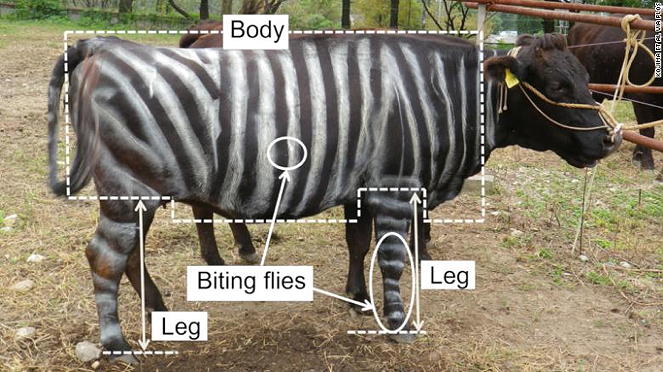
Posted By: Alex - Wed Oct 16, 2019 -
Comments (0)
Category: Science, Cows
The Swastika Chromosomes of D.F. Jones


D.F. Jones
More in extended >>
Posted By: Alex - Fri Oct 11, 2019 -
Comments (0)
Category: Science, 1940s, Pareidolia
Strange Self-Experiments
I just added a top 10 list of strange self-experiments to the site.This is more material that I wrote a while ago, but which no longer has a home. So I'm relocating it permanently to WU.

Posted By: Alex - Mon Sep 16, 2019 -
Comments (1)
Category: Science, Experiments
The Man Who Wanted to Sell Himself to Science
Like a lot of people during the great depression, William Bird of Jacksonville, Vermont had fallen on hard times. He was out of work, heavily in debt, and facing eviction. He feared he would soon be unable to feed his wife and three children. So Bird came up with a plan. He would sell himself to science.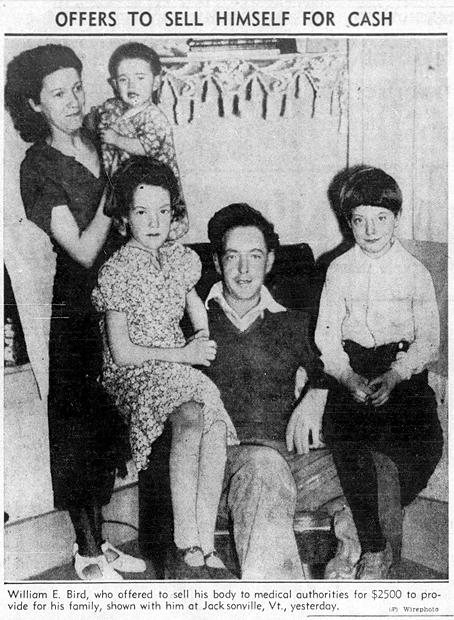
Los Angeles Times - Nov 15, 1936
He announced his offer in November 1936 by sending a letter to the local press. It read, in part:
If there is some doctor or group of doctors or scientists who’ll advance me $2500, I’ll agree to pay it back in two years. I have to sort of sell or mortgage myself because that’s the only security I can put up.
Now, if I failed to pay back the money when the time was up, I’d let them do anything they want with me. I’d let them try and kind of experiment on me.
Soon he sweetened the offer by specifying that it would be all right with him if he didn't survive the experimentation process. Naturally, his wife was opposed to the whole idea.
The media spread his unusual offer nationwide. Reporters noted that he was a prime physical specimen — six feet tall, 175 pounds, and a sturdy workman of good habits. In other words, excellent guinea pig material.
An anonymous Texan took sympathy on Bird and sent him $10. However, the scientific community wasn't tempted. No doctors took him up on his offer.
Although Bird didn't manage to sell himself as a human guinea pig, his story nevertheless had a happy ending. Within days of making his appeal, Bird was given a job on a construction project. He said, "I don't know who was responsible for giving me work, but I sure appreciate it." But he also noted that, despite now having a job, his offer still stood. He was still willing to sell himself to science, should some doctor ever want to take him up on it.

Los Angeles Times - Nov 18, 1936
Posted By: Alex - Mon Sep 09, 2019 -
Comments (2)
Category: Science, Experiments, 1930s

| Who We Are |
|---|
| Alex Boese Alex is the creator and curator of the Museum of Hoaxes. He's also the author of various weird, non-fiction, science-themed books such as Elephants on Acid and Psychedelic Apes. Paul Di Filippo Paul has been paid to put weird ideas into fictional form for over thirty years, in his career as a noted science fiction writer. He has recently begun blogging on many curious topics with three fellow writers at The Inferior 4+1. Contact Us |




